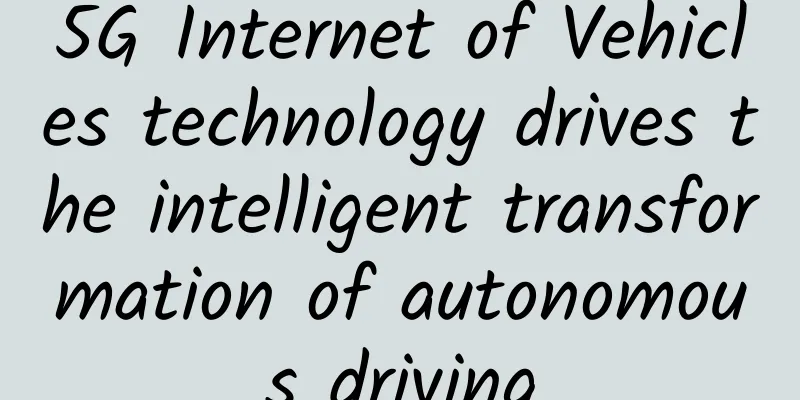5G Internet of Vehicles technology drives the intelligent transformation of autonomous driving

|
2020 is a critical period for the commercial development of 5G in China, and a new chapter has been opened in 5G ecological construction, network deployment, talent training, and industry applications. With the in-depth development of the new four modernizations in the automotive industry, in order to seize the commanding heights of the industry, traditional vehicle manufacturers, parts suppliers, and Internet giants have all made layouts in the field of intelligent connected vehicles, and the research and development and manufacturing of hardware, software, and systems related to the Internet of Vehicles have also become hot.
Based on the Internet of Vehicles, efficient communication can be achieved between vehicles, between vehicles and roads, between vehicles and people, and between vehicles and remote networks. With such powerful communication capabilities, driverless cars will become more intelligent. There is no doubt that 5G Internet of Vehicles has become an important condition for realizing vehicle-road collaboration and autonomous driving. During the autonomous driving process, the shorter the time it takes for the vehicle's sensors to monitor road conditions and command the vehicle's brain to respond, the safer the autonomous driving will be. This requires the communication network to have the characteristics of massive connections, high reliability, and low latency. In the 5G environment, the traffic control platform can issue instructions to the car in a very short time. From the perspective of overall urban transportation, we can find that intelligent networking can achieve deep integration with the city brain that mainly relies on Internet data, and its criticality and importance are self-evident. Industry insiders pointed out that in the future, intelligent networking will be deeply integrated with the city brain, and the data generated by diversified intelligent networking will better serve the city traffic brain and be deeply integrated with traffic Internet data, so as to better present the results of traffic flow analysis and OD analysis. Of course, in the trend of intelligent, connected, electrified and shared vehicles, the status of software cannot be ignored. Whether it is battery management and energy control of new energy vehicles, or functions in the field of intelligent networking such as smart cockpits and autonomous driving, they all need to rely on software to drive and operate. In the vehicle value system, the proportion of autonomous driving related software has also increased rapidly. Recently, the pilot demonstration and pilot zone project construction of Internet of Vehicles in various places has mainly focused on verifying and testing the safety and efficiency services based on LTE-V2X. As operators accelerate the construction of 5G networks, innovative Internet of Vehicles infotainment services based on 5G networks are also being verified, and applications such as panoramic synthesis, in-vehicle AR/VR video calls, and in-vehicle high-definition video surveillance are also accelerating their integration and implementation. In July this year, 3GPP announced the freezing of Rel-16 version, and completed the 5G V2X standard based on the 5G framework for the first time. If the focus of Rel-14 LTE V2X is basic safety applications, 5G V2X makes full use of the characteristics of 5G large bandwidth, low latency, and high reliability to enhance the perception ability between vehicles, and then focus on supporting autonomous driving technology. 5G-related communication technologies have undoubtedly created the necessary conditions for the implementation of autonomous driving. Specifically, in the future, driverless vehicles will need to transmit car navigation information, location information, and data from various car sensors in real time through the network to the cloud or other vehicle terminals. Each vehicle can transmit up to 1GB of data per second in order to grasp the vehicle's operating status and driving behavior in real time. The existing 4G network is difficult to meet such requirements, and 5G networks are needed to provide support. Of course, it will take some time to realize L4 and L5 autonomous driving. According to the forecast of Stanford University in the United States, L4 high-level autonomous driving will be truly realized between 2020 and 2025, and will be first applied to special vehicles such as trucks and shared taxis. For private cars, L4 autonomous driving is expected to be realized around 2030, while L5 autonomous driving will have to wait until at least after 2035. We are in an exciting and opportunity-filled technological era. The rapid integration and iteration of cutting-edge technologies such as 5G, the Internet of Things, artificial intelligence, and edge computing not only promote the practical application of basic theoretical science, but also accelerate the transformation and upgrading of the traditional automotive industry. The bright prospects of the future automotive industry are waiting for the industry insiders to jointly explore and create! |
<<: Report: By 2027, the 5G chip market will be worth $23.5 billion
>>: The “long and short” debate on WeChat video accounts
Recommend
It’s time to issue 5G private network frequency licenses
The Ministry of Industry and Information Technolo...
What is the difference between WiFi and Ethernet connections?
In today's networking world, Wifi and Etherne...
Huawei redefines data infrastructure. Here are the answers to five questions that the industry should be concerned about!
[51CTO.com original article] On May 15, Huawei re...
How to design network architecture to make IoT devices safe and reliable?
[51CTO.com Quick Translation] While the Internet ...
The slowdown in 5G construction is not a problem, 5G application is the key
China Mobile said that the bidding in July has be...
VIAVI Demonstrates Validation, Verification and Visibility Solutions for 5G at Mobile World Congress 2019
VIAVI Solutions, Inc. (NASDAQ: VIAV) will showcas...
Finding strength in numbers: Data center agglomeration effect
In the past, data centers were often built in rem...
A Deep Dive into Data Link Layer Devices
In computer networks, there are multiple layers t...
CommScope’s Viewpoint: Operators’ Network Efficiency Transformation in the 5G Era
Despite the impact of the "black swan" ...
Five realistic predictions for enterprise IT in 2018
As 2017 is coming to an end, many companies are p...
Chip shortages, edge computing and IoT will drive IT transformation in 2022
Forrester Research pointed out in its research th...
V5.NET is 30% off in July, and monthly payment starts from HK$525 for new Korean servers
V5.NET has launched new products. This month, the...
iWebFusion: 1Gbps server starts at $49/month, 10Gbps server starts at $149/month
iWebFusion (or iWFHosting) is a foreign hosting c...
Building the fiber optic network for the next 20 years
The pace of fiber network deployment is accelerat...
Experts in Cyber Threat Response in the Digital Age | Weibo Online Officially Announces Brand Upgrade
Recently, on the occasion of its seventh annivers...









